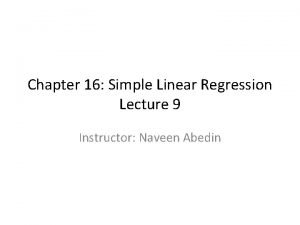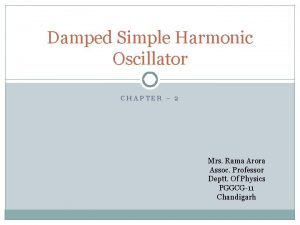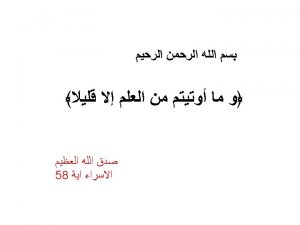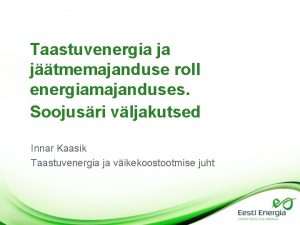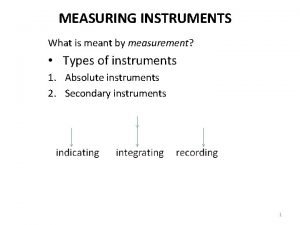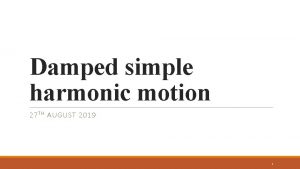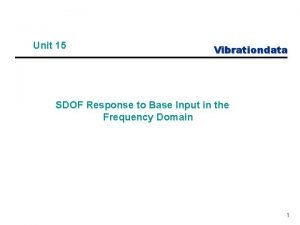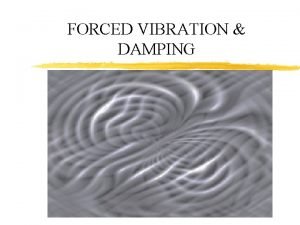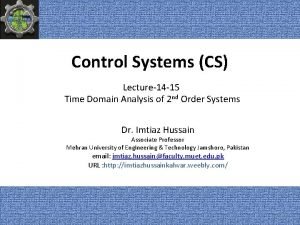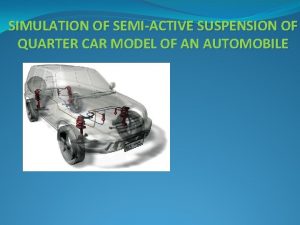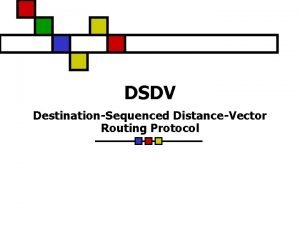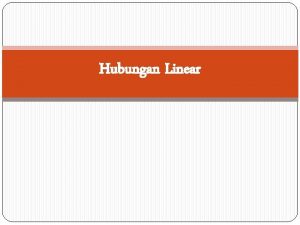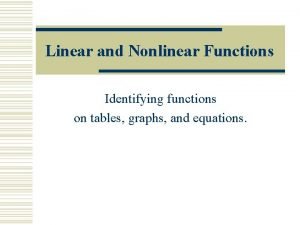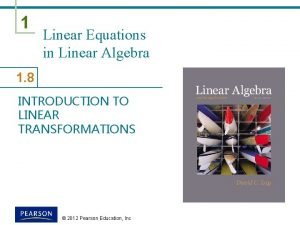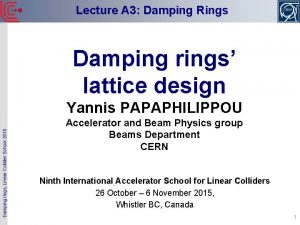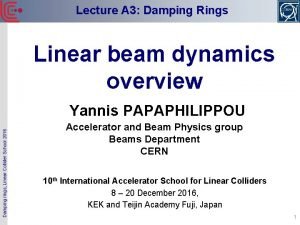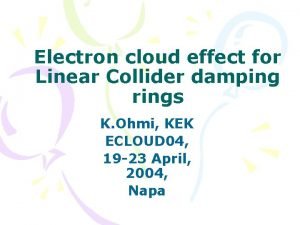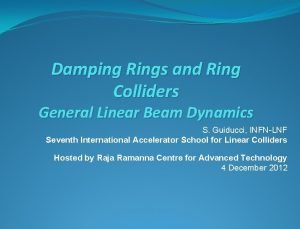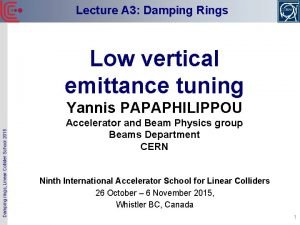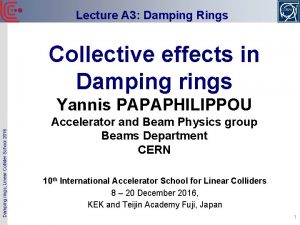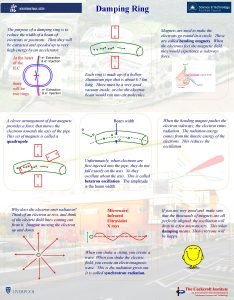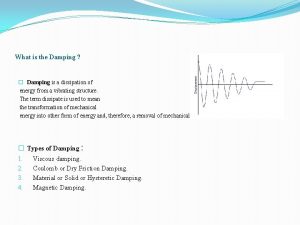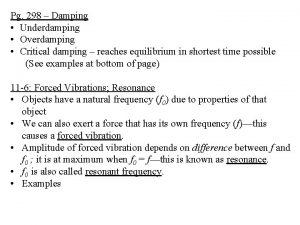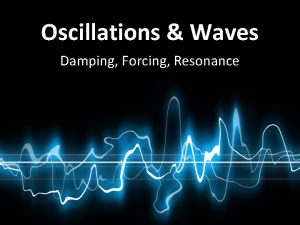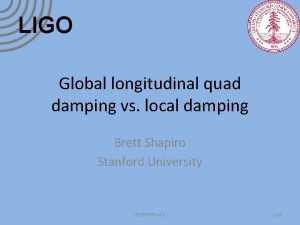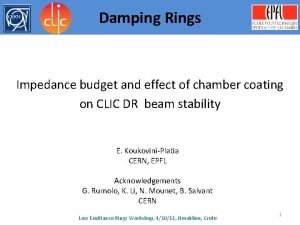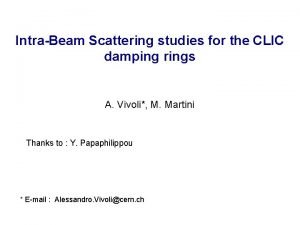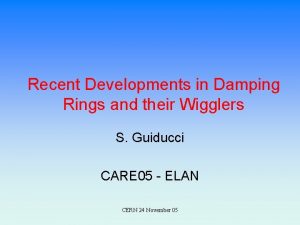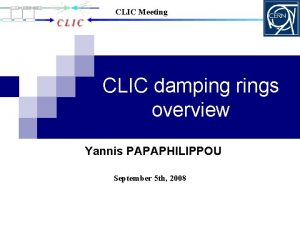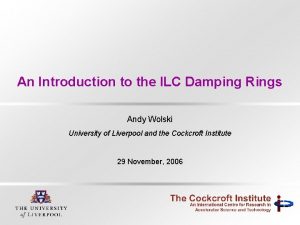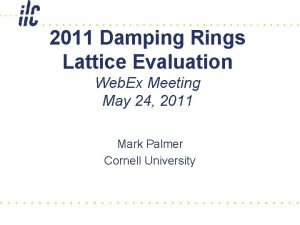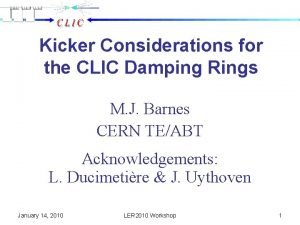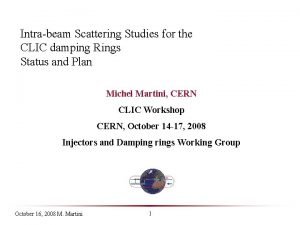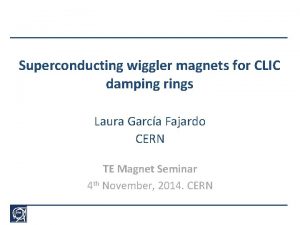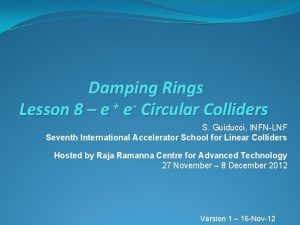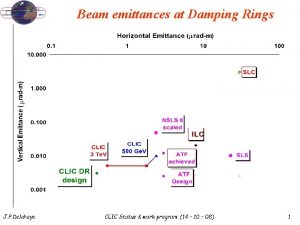Lecture A 3 Damping Rings Damping rings Linear



































- Slides: 35

Lecture A 3: Damping Rings Damping rings, Linear Collider School 2016 Yannis PAPAPHILIPPOU Accelerator and Beam Physics group Beams Department CERN 10 th International Accelerator School for Linear Colliders 8 – 20 December 2016, KEK and Teijin Academy Fuji, Japan

Primary purpose and outline n Overview of the beam physics processes and associated technology driving the design of linear collider damping rings q 12 hours of lectures covering the following areas n Damping rings’ design guidelines and challenges (~1. 5 h) q Role of the damping rings in the LC accelerator complex, review parameters and constraints of LC damping rings , identify key challenges n Linear beam dynamics overview (~1. 5 h) n Beam dynamics with radiation damping (~1. 5 h) Damping rings, Linear Collider School 2016 q Radiation Damping and Synchrotron Motion, Quantum Excitation and Equilibrium Emittance, summary of Beam Parameters and Radiation Integrals n Lattice design and non-linear dynamics for low emittance rings (~1. 5 h) q FODO, DBA, TBA, MBA, TME, chromaticity, non-linear dynamics, ID effects n Ultra-low vertical emittance tuning (~1. 5 h) q Linear imperfections, Coupling, vertical dispersion, alignment tolerances n Collective effects (~3 h) q Single and multi-bunch instabilities, Two stream instabilities, Intrabeam scattering, Touschek effect and space-charge n Damping rings technology (~1. 5 h) q Damping wigglers, kickers, vacuum, instrumentation, feedback 2

General Bibliography n Accelerator physics books K. Wille, The Physics of Particle Accelerators, an introduction, Oxford University press, 2000 q S. Y. Lee, Accelerator Physics, 2 nd edition, World Scientific, 2004 q H. Wiedemann, Particle accelerator physics, 3 rd edition, Springer 2007 q n Lecture notes L. Rivkin, Electron dynamics, CERN Accelerator School in Synchrotron Radiation and freeelectron lasers, 2003; Intermediate CERN Accelerator School, 2007. q A. Wolski, Low emittance machines, CERN Accelerator School, September 2007. q M. Sands, The physics of electron storage rings, an introduction, Proc. Int. School of Phys. E. Fermi, (ed. B. Touschek), 1971. q Damping rings, Linear Collider School 2016 n Design reports A Multi-Te. V linear collider based on CLIC technology: CLIC Conceptual Design Report, CERN-2012 -007 q International Linear Collider Technical Design Report, Vol. 3 q n Lectures on damping rings A. Wolski, Lectures on Damping Rings, 4 th International Accelerator School for Linear Colliders, Beijing, China, 2009. q M. Palmer, Lectures on Damping Rings, 5 th International Accelerator School for Linear Colliders, Villars-sur-Ollon, Switzerland, 2010 q S. Guiducci, Lectures on Damping Rings, 7 th International Accelerator School for Linear Colliders, Indore, India, 2012 q 3

Lecture A 3: Damping Rings Damping rings’ design guidelines and challenges Damping rings, Linear Collider School 2016 Yannis PAPAPHILIPPOU Accelerator and Beam Physics group Beams Department CERN 10 th International Accelerator School for Linear Colliders 8 – 20 December 2016, KEK and Teijin Academy Fuji, Japan

Contents n Role of Damping Rings n The CLIC and ILC design parameters n DR Parameter Requirements q Luminosity Damping rings, Linear Collider School 2016 q Bunch q Main and emittance compressors Linac q Injected emittance n Examples of parameter optimization n ILC and CLIC Damping Rings parameters and challenges 5

Damping rings, Linear Collider School 2016 Role of the Damping Rings n Accept e+ and e- beams with large transverse and longitudinal emittances and damp them by several orders of magnitude producing ultralow emittance beams necessary for high luminosity collisions at the interaction point (IP), within the (fast) repetition rate imposed by the collider n Damp longitudinal and transverse jitter in the incoming beams to provide very stable beams for delivery to the IP n Delay bunches from the source to allow feedforward systems to compensate for pulse-topulse variations ILC CLIC 6

The ILC Design n Machine Configuration for 500 Ge. V center of mass energy q q q Damping rings, Linear Collider School 2016 q Helical undulator polarized e+ source Two ~3. 2 km damping rings in the same tunnel RTML running length of linac Two 11. 2 km main linacs with super-conducting cavities Single Beam Delivery System 2 Detectors in Push-Pull configuration ~8 K cavities/linac operating @ 2°K Bunch Compressors ~31 km 7

The CLIC Design n Machine configuration for 0. 5 and 3 Te. V center of mass energy q q q Damping rings, Linear Collider School 2016 q Non-polarised e+ source Two ~430 m damping rings + two ~400 m predamping rings RTML running length of linac Two ~21 km main linacs with copper cavities Drive beam complex for RF power production Single Beam Delivery System Two Detectors in Push-Pull configuration 8

DR Design Parameters Main goal of this course is to understand why parameters have the specified values and why they are different in the two LC design n Damping rings, Linear Collider School 2016 CLIC ILC 9

The TDR ILC Damping Ring Layout n n n Damping rings, Linear Collider School 2016 n DTC 4 – Racetrack shape Circumference 3. 2 km, energy of 5 Ge. V TME style lattice in the arcs Straight sections filled mostly with FODO cells and include damping wigglers, RF and beam transfer equipment, circumference chicane and phase trombone 10

The CDR CLIC Damping Ring Layout n n n Damping rings, Linear Collider School 2016 n Racetrack shape Circumference 427. 5 m, energy of 2. 86 Ge. V TME in the arcs with gradient dipole Straight sections filled with FODO cells and include damping wigglers, RF and beam transfer equipment 11

LC Damping Ring Design Inputs n A number of parameters are design inputs for the damping rings n They are constrained due to LC physics performance requirements (luminosity), the downstream systems (mainly main linac RF, but also RTML), the upstream systems (particle sources, mainly e+) n They impact damping rings beam dynamics but also technology Parameters Particles per bunch Machine repetition rate [Hz] Damping rings, Linear Collider School 2016 Linac RF pulse length [μs] Bunch spacing in linac/DR [ns] Particles per machine pulse CLIC ILC Constraints Impact on DR design 4× 109 2× 1010 Maximum set by disruption at IP, and linac short range wakefields, minimum set by luminosity target and RF to beam efficiency Single bunch Collective effects, impedance budgets, vacuum, feedback 50 5 Set by cryogenic cooling capacity in ILC, partially determines required damping time Lattice design, layout, damping wigglers parameters 0. 156 1600 Upper limit set by RF technology and RF to beam efficiency Layout, collective effects, extraction kicker design, RF system design (including LLRF) Lower limit set by luminosity target Collective effects Set by positron source, influences damping time requirement Number of damping stages, layout, lattice design, dynamic aperture, magnet tolerances Set by positron source Momentum (dynamic) acceptance, magnet tolerances Set by luminosity goal and emittance growth budget in downstream systems Lattice design, alignment tolerances, collective effects Upper limit set by downstream bunch compressors RF system, collective effects 0. 5/1 554/6 1. 3× 1012 5. 3× 1013 Injected normalized emittance (e +) [μm. rad] 7000 8 Injected rms energy spread [%] ± 4. 5 ± 0. 75 H/V Extracted normalized emittances [nm] 500/5 5000/20 Extracted rms bunch length [mm] 1. 8 6 Extracted rms energy spread [%] 0. 15 12

Luminosity Requirements n The principle parameter driver is the production of luminosity at the collision point where q Assumed equal for all bunches and both beams , the number of particles per bunch and , the horizontal and vertical beam sizes q , the collision rate at the interaction point (IP) q , the number of bunches q , the luminosity factor representing combined effect of “hour glass” (longitudinal beta function change over IP), disruption enhancement (mutual attractive force of colliding bunches) and crossing angle Damping rings, Linear Collider School 2016 q n Ideally the target is High intensity bunches q Small transverse beam size q High repetition rate q Large number of bunches q High brightness 13

Parameters at the ILC Interaction Point n The parameters at the interaction point have been chosen to provide a nominal luminosity of 2× 1034 cm-2 s-1 for ILC n The bunch charge is N = 2× 1010 particles/bunch and we consider 1 bunch n The horizontal beam size sx ~ 474 nm with bx* = 11 mm which requires a geometrical emittance of ex = 20 pm-rad Damping rings, Linear Collider School 2016 n The vertical beam size sy ~ 5. 9 nm with by* = 0. 48 mm which requires a geometrical emittance of ey = 0. 07 pm-rad n The luminosity factor HD~ 2 n For the required luminosity a collision rate of 7 k. Hz is required. n Question: How the 1 bunch consideration and the 7 k. Hz collision rate can be compatible with the ILC damping ring parameters (1312 bunches and 5 Hz machine repetition rate)? n Answer in a few slides… 14

Parameters at the CLIC Interaction Point n The parameters at the interaction point have been chosen to provide a nominal luminosity of 6× 1034 cm-2 s-1 for CLIC n The bunch charge is N = 3. 72× 109 particles/bunch for a total of 312 bunches n The horizontal “core” beam size sx ~ 45 nm (rms of 33. 5 nm) with bx* = 6. 9 mm which is given by a geometrical emittance of exn = 0. 1 pm-rad Damping rings, Linear Collider School 2016 n The vertical “core” beam size sy ~ 0. 9 nm (rms of 0. 5 nm) with by* = 0. 068 mm which is given by a geometrical emittance eyn = 0. 003 pm-rad! n The collision rate now is equal to the machine repetition rate of 50 Hz n For reaching the target luminosity, factor HD has to be equal to 0. 6 n The beta functions at the IP are optimized in the final focus system n Note: LC Luminosity cannot be just a matter of simple scaling. There is an interplay of several effects, such as beam-beam enhancement and disruption, beamstrahlung producing losses and detector background, the hour glass effect, which are usually simulated with dedicated codes 15

Damping rings, Linear Collider School 2016 Emittance Transport from the DR to IP n Having the required geometric emittances at the IP, the emittance at the damping rings can be projected by using a relativistic invariant quantity, the normalized emittance (more details in 2 nd lecture) n By using the conjugate phase space coordinated (x, px) instead of (x, x′) gives: px = p x′ = mcbgx′ n The normalized emittance is defined as en = bgegeo ≈ gegeo for ultra-relativistic particles Twiss parameter x longitudinal acceleration 16

Emittance Transport from DR to the IP Damping rings, Linear Collider School 2016 n From the target normalized emittance at the IP and the estimated emittance growth in the main linac and the RTML, the emittance requirements at the DR extraction can be inferred n For CLIC, the normalized horizontal and vertical emittances at the IP are 660 and 20 nm. rad, respectively n Considering 10% horizontal and 100% vertical emittance growth in the main linac and another 20% and 100% in the RTML, the normalized emittance requirement at the exit of the CLIC DR is 500 and 5 nm. rad n Following the same route for the ILC DR (considering 100% emittance growth in both planes from linac and RTML) the emittance targets at its exit are 5000 and 20 nm. rad, i. e. an order of magnitude higher BMAD/ILCv curve shows error bars Low Emittance Tuning simulation Benchmarking in ILC Main LINAC (J. Smith) 17

Damping rings, Linear Collider School 2016 Emittance targets for LC DR n Computing back the geometrical emittance target for CLIC DR (energy of 2. 86 Ge. V), we obtain 90 and 0. 9 pm. rad in the horizontal and vertical plane n For the ILC damping rings (@ 5 Ge. V), the geometrical emittances are 500 and 2 pm. rad, i. e. still higher but with factors of 2 to 6 n Similar vertical emittances have been achieved today in various low emittance rings, with SLS and Australian light source storage rings holding the record by having reached and even supersede the CLIC target n The horizontal emittance is unprecedented but several synchrotron light source projects are approaching it (e. g. ESRF) or even targeting lower emittances (e. g. ALS-U) n The main difference with other low emittance rings is that DR (especially for CLIC) necessitate to have also very small longitudinal emittance (bunch length and energy spread) as explained in the next slide n This makes the DR beam dynamics (especially for CLIC) largely dominated by collective effects 18

Damping rings, Linear Collider School 2016 Bunch Compressors n After extraction from DRs, beam goes through bunch compressors, which manipulate phase space so as to shrink the bunch length from a few mm down to tens or hundreds of μm as required by the main linac and IP n Both ILC and CLIC are considering 2 bunch compression stages taking the bunch length from 6 and 1. 8 mm down to 300 and 40 μm respectively n From the downstream point of view, lowering the bunch length means cheaper and simpler bunch compression schemes n From the DR point of view, shorter bunches require smaller values of the momentum compaction (lattice design) or higher RF voltage (more RF units, hence greater cost). Shorter bunches indeed imply bigger sensitivity to collective effects ILC RTML CLIC RTML 19

Main Linac RF system impact Damping rings, Linear Collider School 2016 ILC RF n The bunch-train structure is largely determined by the design and performance of the RF system of the Main Linac (ML) n Due to the different technology of CLIC and ILC main RF (superconducting vs. normal conducting), the design of the two DRs, vary significantly CLIC RF 20

Damping rings, Linear Collider School 2016 ILC Main Linac RF system impact n For the ILC DRs, the RF power system (1. 3 GHz klystrons of 10 MW) imposes the total RF pulse of 1. 6 ms and considering the filling time of the cavity of 0. 87 ms, the beam pulse length is 0. 73 ms n At the same time, due to RF peak power requirements, the nominal average current for each beam pulse should be 5. 8 m. A n The dynamic cryogenic load (refrigeration) is a cost driver and imposes the nominal machine repetition rate of 5 Hz n Considering the bunch population to be 2 x 1010 particles, leads to the nominal bunch train number of 1312 bunches per pulse and thereby the bunch spacing of 554 ns for uniform loading through the pulse n The resulting collision rate at the IP is then 7 k. Hz consistent with the target luminosity n The 5 Hz repetition rate places the primary constraint on the DR damping times q In order for the bunches in each pulse to experience 8 full damping cycles, a transverse damping time of ≤ 25 ms is required. 21

ILC Bunch Train structure n The basic ILC bunch train structure of 0. 73 ms with 1312 uniformly spaced bunches with 554 ns between them results to a train length of 220 km, which cannot fit to a reasonable ring circumference n Thus, the damping rings must act as a reservoir to store the full train n The long bunch train has to be folded (or compressed) into a much shorter ring, and it has to be decompressed while extracted, through a bunch-bybunch extraction scheme Injection Systems Damping rings, Linear Collider School 2016 DR Extraction to RTML n A “trade-off” is necessary between the bunch spacing in the ring (the longest possible for reducing e-cloud build-up and increasing the extraction kicker rise/fall times) and its circumference (the shortest possible for cost but also reduction of single bunch collective effects, as space-charge and IBS) n There is significant overlap between the injection and extraction cycles for maintaining constant beam loading and each extracted bunch position is filled 22 by the injected bunch

Damping rings, Linear Collider School 2016 CLIC Main Linac RF system impact n A scaling law between RF pulse length, accelerating field and break-down rates of the CLIC ML X-band RF cavities necessitates very short pulse lengths of 156 ns n A short bunch spacing is also favored in order to improve the RF-to-beam efficiency and a value of 0. 5 ns is chosen (6 cycles of the 12 GHz RF system) n The resulting train of 312 bunches can easily fit to a ring of circumference of around 100 m, even taking into account confortable injection/extraction kicker rise/fall times n This circumference is quite low though for realizing an ultra-low emittance magnet structure with reasonable magnet-to-magnet distances and also get the ultra-low damping times for fitting to the machine pulse of 20 ms (50 Hz repetition rate) n Thus the ring circumference is ~400 m, an order of magnitude longer than the bunch train n On the other hand, a 2 GHz RF system is imposed to the DRs which is extremely challenging with respect to the power source, the high and average and peak current and the associated LLRF system dealing with severe transient beam loading 23

Injected emittance and damping time Damping rings, Linear Collider School 2016 n Positron production via a heavy metal target results in much larger emittances due to scattering in the target for positrons n Electrons can be produced with much smaller emittances through an optimized design of the injector gun and its cathode n The (e+) injected emittance partially determines the damping time n The approach to the target extraction emittance of the ILC DR (20 nm. rad) is shown for various damping times assuming the target e+ injected emittance (en = 0. 01 m. rad) and for “zero-current” beam (no collective effects) n This justifies the consideration t = 21 ms 24 ms 27 ms of damping times < 25 ms tc /t 200/27 = 7. 4 200/24 = 8. 3 200/21 = 9. 5 24

Damping rings, Linear Collider School 2016 Injected emittance and acceptance n The injected beams have large betatron amplitudes and energy spread n This requires that the acceptance of the DR to be sufficiently large to accommodate these beams n It places important constraints on the minimum aperture of the vacuum system and the minimum good field regions of all of the magnets but also magnetic error tolerances and non-linear optimisation for adequate dynamic aperture n In the case of CLIC, the injected emittance cannot be digested directly to the DRs, necessitating pre-damping rings, even for electrons (especially due to the very short beam cycle of 20 ms) Particle capture rates assuming that the limiting physical aperture in the ILC DRs is due to the vacuum chambers in the wiggler regions. The choice of a superferric wiggler design, with large physical aperture, allows for a DR design with full acceptance. 25

Reaching an optimized DR design n Taking into account the requirements previously mentioned Train structure q Equilibrium emittance requirements q Bunch length requirements q Bunch current q Acceptance of ring q Timing structure Damping rings, Linear Collider School 2016 q n Choose adequate parameters for reaching desired DR performance Design typically implies various compromises between parameters q Parameters must be robust and flexible enough to match paths of evolution of the overall machine design (e. g. future upgrades) q 26

Damping rings, Linear Collider School 2016 Example: Ring Circumference n Large circumference implies that collective effects (IBS, space charge) are more severe n If collective effects are significant, higher energy is desirable n Higher energy means larger equilibrium emittance due to quantum excitation but also larger ring… n Small circumference implies fewer components and smaller tunnel so cheaper and potentially better net hardware reliability n On the other hand, the folding of the linac bunch train into the ring requires more closely spaced bunches n Closely spaced bunches impose more challenging bunchby-bunch injection and extraction and electron cloud and fast ion effects become more severe 27

Damping rings, Linear Collider School 2016 Example: Beam Ring Energy n For higher energy, sensitivity to collective effects (beam instabilities, intrabeam scattering, space charge, etc) is weakened n Higher energy provides increased damping rates due to higher synchrotron radiation n For a given normalized emittance from the sources, higher energy provides smaller geometrical emittance due to adiabatic damping from the initial beam acceleration and the ring acceptance issues are eased n Lower energy provides a smaller equilibrium emittance but without taking into consideration collective effects n Lower energy implies weaker magnets and lower field RF cavities to focus the beam, hence cheaper (and often more reliable) hardware 28

Damping rings, Linear Collider School 2016 Example: High Voltage Kickers n Wide kicker pulse is typically more stable, hence better for uniform injection/extraction n Wide kicker pulse requires a large ring circumference to allow bunch-by-bunch injection and extraction (bunch spacing) n Wide kicker pulse necessitates relatively fewer kicker structures (matched to pulse width), minimizing impedance issues, improving reliability, minimize cost… n Wide kicker pulse works well in a scenario with full train injection/extraction n Narrow kicker pulse implies higher bandwidth which requires careful impedance matching with kicker structure n Many short kicker structures are required for a narrow kicker pulse (reliability and cost concerns) n Narrow kicker pulse combined with high voltage pulses may be quite challenging 29

Example: Damping Wigglers n Competing technologies: Permanent magnet q Normal conducting electromagnet q Superconducting electromagnet q n Performance issues: q q q Damping rings, Linear Collider School 2016 q q Aperture Allowable field strength Field quality Sensitivity to radiation damage Operating cost n ILC design choice: Employ only a damping ring with no pre-damping ring q Places significant weight on aperture and field quality issues in order to handle the large input beams from the positron source q n CLIC choice: Use pre-damping rings, easing aperture requiremens of DR q Use SC damping wigglers for reaching target emittance within ultra-fast beam cycle q 30

Damping rings, Linear Collider School 2016 Example: Physics requirements n Provide wider energy range for producing luminosity n This affects the polarised positron production mode for ILC and increases significantly bunch charge and train length for CLIC n ILC positron production is at fixed energy point in main linac n A lower energy ILC needs to produce positrons on one pulse and then change the acceleration in the ML for collisions on a separate pulse n For this two pulse configurations, the positron damping ring only filled 50% of time which means new RF system design and increase of damping rate so that 5 Hz pulses for collision can be maintained n Lower positron production energy means lower production yield and inability to achieve desired standard operating parameters n Lower positron production energy has potentially unacceptable impact on the positron target design 31

ILC DR Design n The ILC DR baseline configuration is able to meet the key design parameters required for the baseline design q Validation of the various design choices continues limiting areas of operational concern identified for further R&D included Damping rings, Linear Collider School 2016 q Major n Achievement of 2 pm vertical emittance n Electron Cloud effects n Fast Ion effects n Ability to stably inject and extract closely spaced bunches q An aggressive R&D program has been underway for addressing these issues at CESRTA and ATF 32

CLIC DR challenges and adopted solutions n High-bunch density in all three dimensions q q Damping rings, Linear Collider School 2016 q Intrabeam Scattering effect reduced by choice of ring energy, lattice design, wiggler technology and alignment tolerances Electron cloud in e+ ring mitigated by chamber coatings and efficient photon absorption Fast Ion Instability in the e- ring reduced by low vacuum pressure and large train gap Space charge vertical tune-shift limited by energy choice, reduced circumference, bunch length increase Other collective instabilities controlled by low – impedance requirements on machine components n Repetition rate and bunch structure q q Fast damping times achieved with SC wigglers RF frequency reduction @ 1 GHz considered due to many challenges @ 2 GHz (power source, high peak and average current, transient beam loading) n Output emittance stability q Tight jitter tolerance driving kicker technology n Positron beam dimensions from source q Pre-damping ring challenges (energy acceptance, dynamic aperture) solved with lattice design 33

Damping rings, Linear Collider School 2016 Some ILC-CLIC Comparisons Parameter Energy Circumference Nominal # of bunches & particles/bunch Macropulse Repetition Rate Average current Energy loss per turn RF Frequency Total RF voltage Equilibrium normalized emittance, gex Natural Chromaticity, cx/cy Momentum compaction, ac Bunch length, sz Momentum spread, sp/p Horizontal damping time, tx Longitudinal damping time, tz Units Ge. V km Hz A Me. V MHz MV mm·rad mm ms ms ILC DR (RDR) CLIC DR 5. 0 3. 238 1312@2. 0× 1010 5 0. 4 4. 5 650 14 5. 7 -51/-43 3. 3 × 10 -4 6. 0 1. 1 × 10 -3 24. 0 12. 0 2. 86 0. 428 312@0. 41× 1010 50 0. 15 4. 0 2000 (1000) 10 0. 46 -115/-85 1. 3 × 10 -4 1. 6 (1. 8) 1. 0 × 10 -3 2. 0 1. 0 34

Summary n Overview of some of the key design issues for the CLIC and ILC damping rings Damping rings, Linear Collider School 2016 n DR design has to comply with numerous constraints and design requirements imposed by upstream and downstream systems n DR offer a wide spectrum of challenges both for beam dynamics and the required hardware n The optimization process involves complicated trade-offs to meet physics specifications n The rest of the course will cover as much as possible the beam physics of LC DRs and its impact to the associated technology 35
 01:640:244 lecture notes - lecture 15: plat, idah, farad
01:640:244 lecture notes - lecture 15: plat, idah, farad Linear regression lecture
Linear regression lecture Relaxation time of damped harmonic oscillator
Relaxation time of damped harmonic oscillator Atwood's classification of residual ridges
Atwood's classification of residual ridges Simple harmonic motion notes
Simple harmonic motion notes Explain damping torque
Explain damping torque Clasp knife response
Clasp knife response Deflecting torque definition
Deflecting torque definition Roll damping
Roll damping Eddy current damping in measuring instruments
Eddy current damping in measuring instruments Heavy damping graph
Heavy damping graph Damping coefficient c
Damping coefficient c Heavy damping
Heavy damping Damping ratio in control system
Damping ratio in control system Damping coefficient c
Damping coefficient c Damping in dsdv
Damping in dsdv Contoh soal metode numerik biseksi dan penyelesaiannya
Contoh soal metode numerik biseksi dan penyelesaiannya Non linear tables
Non linear tables Cara penggal lereng
Cara penggal lereng Linear pipeline in computer architecture
Linear pipeline in computer architecture Simultaneous equations linear and non linear
Simultaneous equations linear and non linear Fungsi non linier fungsi kuadrat
Fungsi non linier fungsi kuadrat Linear texts examples
Linear texts examples Linear impulse and momentum
Linear impulse and momentum Linear or nonlinear table
Linear or nonlinear table Types of multimedia
Types of multimedia Closure properties of regular languages
Closure properties of regular languages Linear independence
Linear independence Linear narrative definition
Linear narrative definition Difference between linear and nonlinear equation
Difference between linear and nonlinear equation Convert left linear to right linear grammar
Convert left linear to right linear grammar Simple and multiple linear regression
Simple and multiple linear regression O q é enredo
O q é enredo Contoh soal persamaan simultan 3 variabel
Contoh soal persamaan simultan 3 variabel Linear algebra linear transformation
Linear algebra linear transformation Contoh soal dan penyelesaian metode iterasi sederhana
Contoh soal dan penyelesaian metode iterasi sederhana

